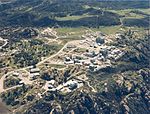Upper Las Virgenes Canyon Open Space Preserve
2003 establishments in CaliforniaCalabasas, CaliforniaHidden Hills, CaliforniaHistory of the San Fernando ValleyMovie ranches ... and 11 more
Nature reserves in CaliforniaParks in Los Angeles County, CaliforniaParks in Ventura County, CaliforniaParks in the San Fernando ValleyProtected areas established in 2003Regional parks in CaliforniaSanta Monica Mountains National Recreation AreaSimi HillsUse mdy dates from April 2022West Hills, Los AngelesWoodland Hills, Los Angeles

The Upper Las Virgenes Canyon Open Space Preserve is a large open space nature preserve owned and operated by the Santa Monica Mountains Conservancy spanning nearly 3,000 acres (1,200 ha) in the Simi Hills of western Los Angeles County and eastern Ventura County. Originally part of Ahmanson Ranch, this area was sold by Seattle-based Washington Mutual to the Santa Monica Mountains Conservancy in late 2003 after lengthy issues concerning development in the chaparral shrub forest and oak savanna understory and overstory Plant communities. It was previously called Ahmanson Ranch Park.
Excerpt from the Wikipedia article Upper Las Virgenes Canyon Open Space Preserve (License: CC BY-SA 3.0, Authors, Images).Upper Las Virgenes Canyon Open Space Preserve
Geographical coordinates (GPS) Address Nearby Places Show on map
Geographical coordinates (GPS)
| Latitude | Longitude |
|---|---|
| N 34.184187 ° | E -118.701538 ° |
Address
Ventura County
California, United States
Open on Google Maps







